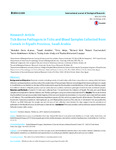Tick-Borne Pathogens in Ticks and Blood Samples Collected from Camels in Riyadh Province, Saudi Arabia
| dc.contributor.author | ALanazi, AD | |
| dc.contributor.author | Abdullah, S | |
| dc.contributor.author | Helps, C | |
| dc.contributor.author | Wall, R | |
| dc.contributor.author | Puschendorf, Robert | |
| dc.contributor.author | ALHarbi, SA | |
| dc.contributor.author | Abdel-Shafy, S | |
| dc.contributor.author | Shaapan, RM | |
| dc.date.accessioned | 2018-10-15T13:53:40Z | |
| dc.date.issued | 2018-10-15 | |
| dc.identifier.issn | 1811-9778 | |
| dc.identifier.issn | 1811-9786 | |
| dc.identifier.uri | http://hdl.handle.net/10026.1/12540 | |
| dc.description.abstract |
Background and Objective: Domestic animals, including camels, in Saudi Arabia suffer from various diseases, among which tick-borne infections are important because they reduce the productivity of these animals. However, knowledge of tick-borne pathogens in camels in Saudi Arabia is very limited, so the aims of this study were to quantify the abundance and distribution of tick species infesting camels from different districts of Riyadh province and use molecular tools to detect tick-borne pathogens in both the ticks and blood samples. Materials and Methods: A total of 218 ticks were collected from 116 camels from the 5 districts of Riyadh. The ticks and camel blood samples were analyzed for Borrelia, Babesia and Theileria pathogens using conventional and real-time PCR. Results: The results showed that five different tick species were identified. Majority of the ticks were Hyalomma dromedarii (70.6%), which were collected from camels in all 5 districts. This was followed by Hyalomma impeltatum species (25.2%), which was again found in all the districts. The other species found were Hyalomma anatolicum, Haemaphysalis sp. and Rhipicephalus turanicus. The only one H. dromedarii tick was positive for Theileria sp. DNA. Although the sample size and the area of tick collection were limited, the data suggest that the prevalence of pathogens in the Riyadh province, Saudi Arabia is relatively low. Conclusion: The study provides useful preliminary data to inform future full-scale country-wide surveys. | |
| dc.format.extent | 30-36 | |
| dc.language.iso | en | |
| dc.publisher | Academic Journals, New York | |
| dc.subject | Infectious Diseases | |
| dc.subject | Emerging Infectious Diseases | |
| dc.subject | Vector-Borne Diseases | |
| dc.title | Tick-Borne Pathogens in Ticks and Blood Samples Collected from Camels in Riyadh Province, Saudi Arabia | |
| dc.type | journal-article | |
| dc.type | Journal Article | |
| plymouth.issue | 1 | |
| plymouth.volume | 14 | |
| plymouth.publication-status | Published | |
| plymouth.journal | International Journal of Zoological Research | |
| dc.identifier.doi | 10.3923/ijzr.2018.30.36 | |
| plymouth.organisational-group | /Plymouth | |
| plymouth.organisational-group | /Plymouth/Faculty of Science and Engineering | |
| plymouth.organisational-group | /Plymouth/Faculty of Science and Engineering/School of Biological and Marine Sciences | |
| plymouth.organisational-group | /Plymouth/REF 2021 Researchers by UoA | |
| plymouth.organisational-group | /Plymouth/REF 2021 Researchers by UoA/UoA06 Agriculture, Veterinary and Food Science | |
| plymouth.organisational-group | /Plymouth/Users by role | |
| plymouth.organisational-group | /Plymouth/Users by role/Academics | |
| dcterms.dateAccepted | 2018-10-15 | |
| dc.rights.embargodate | 2018-10-27 | |
| dc.identifier.eissn | 1811-9786 | |
| dc.rights.embargoperiod | Not known | |
| rioxxterms.versionofrecord | 10.3923/ijzr.2018.30.36 | |
| rioxxterms.licenseref.uri | http://www.rioxx.net/licenses/all-rights-reserved | |
| rioxxterms.licenseref.startdate | 2018-10-15 | |
| rioxxterms.type | Journal Article/Review |


